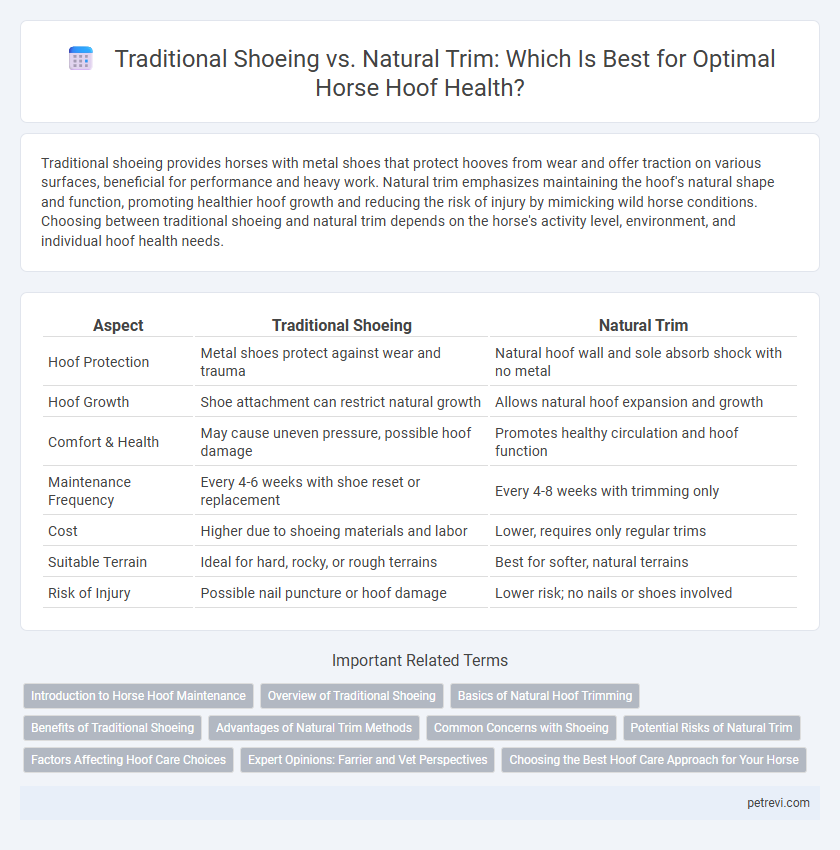Traditional shoeing provides horses with metal shoes that protect hooves from wear and offer traction on various surfaces, beneficial for performance and heavy work. Natural trim emphasizes maintaining the hoof's natural shape and function, promoting healthier hoof growth and reducing the risk of injury by mimicking wild horse conditions. Choosing between traditional shoeing and natural trim depends on the horse's activity level, environment, and individual hoof health needs.
Table of Comparison
| Aspect | Traditional Shoeing | Natural Trim |
|---|---|---|
| Hoof Protection | Metal shoes protect against wear and trauma | Natural hoof wall and sole absorb shock with no metal |
| Hoof Growth | Shoe attachment can restrict natural growth | Allows natural hoof expansion and growth |
| Comfort & Health | May cause uneven pressure, possible hoof damage | Promotes healthy circulation and hoof function |
| Maintenance Frequency | Every 4-6 weeks with shoe reset or replacement | Every 4-8 weeks with trimming only |
| Cost | Higher due to shoeing materials and labor | Lower, requires only regular trims |
| Suitable Terrain | Ideal for hard, rocky, or rough terrains | Best for softer, natural terrains |
| Risk of Injury | Possible nail puncture or hoof damage | Lower risk; no nails or shoes involved |
Introduction to Horse Hoof Maintenance
Proper horse hoof maintenance is essential for equine health and performance, relying on either traditional shoeing or natural trimming methods. Traditional shoeing involves attaching metal shoes to protect hooves from wear and enhance traction, while natural trim focuses on preserving the hoof's natural shape and function without artificial support. Understanding the benefits and limitations of each approach helps in making informed decisions tailored to a horse's specific needs and activities.
Overview of Traditional Shoeing
Traditional shoeing involves attaching metal horseshoes to a horse's hooves using nails, designed to protect the hoof from wear and provide traction on various surfaces. This method has been widely used in equestrian practices to prevent cracking, splitting, and excessive wear, especially for horses working on hard or abrasive terrain. Blacksmiths tailor shoes to meet specific performance needs, such as support for horses with lameness or specialized activities like jumping and racing.
Basics of Natural Hoof Trimming
Natural hoof trimming involves shaping the horse's hoof to replicate its wild, unshod state, promoting healthy hoof growth and function. This method emphasizes regular, balanced trimming of the hoof wall, sole, and frog to maintain proper biomechanics and prevent common issues like cracking or infection. Unlike traditional shoeing, natural trims support natural shock absorption and circulation, enhancing overall hoof health and performance.
Benefits of Traditional Shoeing
Traditional shoeing offers enhanced hoof protection by preventing excessive wear and damage during rigorous activities, supporting horses used in riding, work, or competition. It provides improved traction on various surfaces, reducing the risk of slipping and injury, which is crucial for performance and safety. The method also allows for corrective hoof support, addressing conformational issues and promoting proper limb alignment.
Advantages of Natural Trim Methods
Natural trim methods promote healthier hoof function by preserving the horse's natural biomechanics and encouraging stronger, more resilient hoof walls. This approach reduces the risk of common hoof problems such as laminitis and thrush by maintaining natural moisture balance and sole concavity. Horses trimmed naturally often experience improved comfort, increased hoof circulation, and enhanced shock absorption compared to traditional shoeing.
Common Concerns with Shoeing
Traditional shoeing raises common concerns such as restricting the hoof's natural flexion, potentially leading to decreased circulation and increased risk of hoof cracks or bruising. Shoeing can also trap moisture and debris, creating an environment conducive to thrush and other infections. Natural trim advocates emphasize preserving the hoof's anatomy to promote stronger, healthier hoof growth and reduce reliance on frequent farrier visits.
Potential Risks of Natural Trim
Natural trim for horse hoof maintenance may lead to increased risk of hoof cracking and abscess formation if not performed correctly or frequently enough. Without the protective barrier of traditional metal shoes, horses can experience excessive hoof wear on hard or abrasive surfaces, potentially causing lameness. Horses transitioning from traditional shoeing to natural trim require careful management to prevent pain and injury due to sudden changes in hoof support.
Factors Affecting Hoof Care Choices
Factors affecting hoof care choices between traditional shoeing and natural trim include the horse's workload, hoof health, and environment. Horses engaged in heavy riding or terrain with hard, abrasive surfaces often benefit from protective steel shoes to prevent wear and injury. Conversely, natural trims support hoof biomechanics and moisture balance, making them ideal for horses in softer terrains with minimal performance demands.
Expert Opinions: Farrier and Vet Perspectives
Farriers emphasize traditional shoeing for protection and support in performance horses, citing durability and injury prevention. Veterinarians often advocate natural trim to maintain hoof biomechanics and promote circulation, reducing reliance on artificial devices. Both experts agree that individual horse needs and environment should guide the choice between shoeing and natural trimming.
Choosing the Best Hoof Care Approach for Your Horse
Selecting the best hoof care approach for your horse involves weighing the benefits of traditional shoeing, which offers protection and support for performance horses, against the natural trim method that promotes hoof health and natural wear. Key factors include the horse's workload, environment, and hoof condition, with traditional shoeing often preferred for horses in high-impact disciplines, while natural trim suits those in pasture or light work. Consultation with an experienced farrier or hoof care specialist ensures a tailored plan that maintains optimal hoof balance and soundness.
Traditional Shoeing vs Natural Trim for Horse Hoof Maintenance Infographic

 petrevi.com
petrevi.com